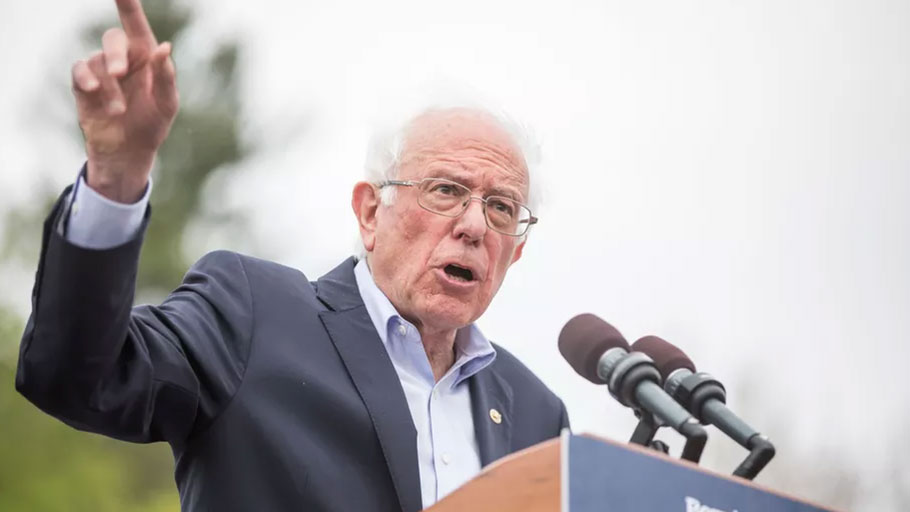He wants to mandate employee ownership of big companies
Bernie Sanders wants to help workers own a portion of the companies at which they are employed.
Per a report from the Washington Post’s Jeff Stein, Sanders is preparing a plan that would mandate corporations “regularly contribute a portion of their stocks to a fund controlled by employees, which would pay out a regular dividend to the workers.”
There aren’t many details on this plan yet, so it’s hard to compare it with much specificity to Elizabeth Warren’s plan that mandates 40 percent of corporate board members be elected by workers, or even to Hillary Clinton’s 2016 proposal to offer a tax break for profit-sharing payments made by corporations to their workers.
But Sanders’s most ardent socialist backers are already comparing it to the fabled Meidner plan, a 1970s initiative in which the social democratic government of Sweden sought to set up “wage earner funds” where workers would pay in payroll taxes and then gradually buy up majority stakes in all Swedish corporations. Eventually, right-leaning parties in Sweden (and the scared Social Democrats who tacked right to win back power) forced the proposal’s defeat. That said, a version of the idea has recently been taken up again by party leader Jeremy Corbyn and shadow chancellor John McDonnell in the British Labour Party, sparking hopes that Sanders, Corbyn’s American equivalent, will embrace it as well.
In its strongest form, Sanders’s plan could amount to a Meidner-esque attempt to achieve real democratic socialism — democratic ownership and control over the means of production. In its weakest form, the plan could be mostly vestigial, a symbolic effort to boost worker power that barely changes material conditions on the ground.
How employee ownership might work
Characterizing the Sanders plan, at this point, amounts to an exercise in reading tea leaves. We don’t know what percentage of shares it would require corporations to contribute, what the target percentage of shares owned by employees would be (40 percent? 50 percent? 60 percent?), whether these would be voting or non-voting shares, and so on.
However, The Next System Project, a policy research group in DC, conducted polling on the idea with some increased specificity. They asked Americans if they would “support or oppose a policy requiring companies with over 250 employees to put 2 percent of their shares into a workers fund each year, up to a maximum of 50 percent, which would pay dividends out to the company’s employees.”
Fifty-five percent of respondents supported the idea and only 20 percent opposed it:
New polling from YouGov/@DemocracyCollab shows that 55% of Americans would support requiring companies to gradually transfer half their equity into worker-controlled Inclusive Ownership Funds that would pay all workers a dividend. A mere 20% oppose. https://t.co/Bo7x6nDpXV pic.twitter.com/mKTXa9sSFi
— Peter Gowan (@peterjgowan) May 27, 2019
This isn’t an issue — like abortion or gun control — that Americans have a lot of familiarity in debating, so I wouldn’t take this polling result as definitive. But it’s certainly a sign that Americans don’t reject the idea out of hand.
A plan to gradually build up 50 percent worker ownership of all large firms would go beyond the “Inclusive Ownership Funds” plan of Corbyn and McDonnell in the UK, which maxes out employee ownership at 10 percent. But both the polled policy and the British policy have a focus on firm-level reforms in common: Workers would gain ownership of their firms, not of a chunk of the economy overall.
These plans go substantially farther than Democratic politicians, including Sanders, have gone so far. Democrats have traditionally backed ideas like employee stock ownership plans (ESOPs), that encourage the distribution of shares to employees, often as part of retirement plans. In a more concrete statement of his priorities on Tuesday, Sanders and a group of other Democratic senators — including fellow presidential contenders Kirsten Gillibrand and Elizabeth Warren and Sens. Patrick Leahy, Maggie Hassan, Jeanne Shaheen, Richard Blumental, and Sherrod Brown — sponsored a bill creating a $500 million US Employee Ownership Bank and offering $45 million in subsidies to states to encourage the formation of employee-owned companies.
The most recent meta-analysis of studies on employee ownership suggests positive, but small, effects on company performance. Skeptics have long pointed to the fact that ESOPs are often structured as retirement plans — investing retirement funds in the company’s own stock as opposed to in index or mutual funds, say — as a reason for caution. Enron’s employee stock ownership plan left employees vulnerable after the company failed, for instance.
But whether a good idea or not, ESOPs fall short of actual employee ownership. There’s no guarantee the stocks they offer will amount to 50 percent, or even 10 percent, of total company shares. They also don’t offer direct dividends and profit-sharing. By contrast, Peter Gowan, a policy associate at the The Next System Project and a vocal employee ownership advocate, notes that the Corbyn proposal pays out as an annual dividend, rather than in retirement.
“Labour are proposing an asset-locked trust which workers would not cash out of upon retirement and instead would pay dividends over the course of their employment,” he told me in a Twitter DM. “This means that the workers can choose to either spend their dividend or put it in a diversified retirement plan, but either way a stock price fall before a worker’s retirement isn’t going to wipe out their retirement savings and they will know this in advance.”
There are more moderate proposals for profit sharing that fall short of actual distributed ownership, like Hillary Clinton’s 2016 campaign proposal to give a tax break to profits distributed to employees. Skeptics of that plan argued it would be easily gamed; companies could capture the tax break by reclassifying existing pay as profits distributed to workers, without benefiting workers or increasing ownership in a real, durable way. The Sanders approach of distributing actual shares would, instead, require companies to pay out the same dividends to employees that they pay to private investors they want to woo, which might reduce the odds of gaming.
But even actual ownership has its drawbacks. By enabling ownership on a firm level, a Corbyn-style plan would lock in inequalities between workers in different firms. A recent paper by labor economists Jae Song, David Price, Fatih Guvenen, Nicholas Bloom, and Till von Wachter found that two-thirds of earning inequality in the US has been generated by differences between high-paying and low-paying companies.
“Firms may have become increasingly unequal in the earnings they pay their workers above common market wages … because some firms had become economic ‘winners’ and are sharing the increased profits with their workers, whereas other ‘loser’ firms are not,” they write.
If that’s true, then a proposal that pools earnings within the “winner” firms, and within the “loser” firms, wouldn’t target a potent source of inequality.
A way to get around this would be to establish a sovereign wealth fund that holds stock in all large companies instead of individual funds for each company. That way, employees in lower-performing firms would get higher payouts, subsidized by employees in more successful firms. But that approach would sacrifice the connection to one’s own firm provided in the Corbyn plan. “I think there is a stronger intuition among people that they are entitled to share in control and ownership over the company they spend their time in than, for instance, 1 share in hundreds of millions of every company in America,” Gowan explained to me.
What are we trying to do here?
As the range of ideas limned above likely suggests, “employee ownership” can mean a lot of things. Some of those things are utterly banal. A large number of companies are already majority-owned by their employees, including Publix Supermarkets, WL Gore & Associates (the makers of Gore-Tex), and Norton publishers.
There appear to have been benefits of that approach for those companies’ employees. This research overview (by a pro-employee ownership group, so caveat emptor) suggests modestly higher compensation (around 4 percent) and lower layoff rates at employee-owned firms.
So encouraging those programs could yield mild benefits for employees. But “a 4 percent raise” doesn’t exactly sound like “the end of capitalism.” Nor does the £500 (~ $633) maximum annual dividend the UK Labour Party has suggested for its funds sound like a huge game-changer. If you want to raise wages, why not just increase the minimum wage, mandate higher wages, or increase the Earned Income Tax Credit? If you want to reduce layoffs, why not adopt policies to prevent recessions? Isn’t boosting employee ownership a really roundabout way to achieve these ends?
There are two possible answers here. One is that expanding employee ownership, just like putting worker seats on corporate boards, would expand worker voice. The collapse of American unions over the last few decades has meant that fewer and fewer workers have an organized institutional voice through which to demand raises, register grievances, ensure fair work rules, and so on. Many in the labor movement are embracing ideas like board seats and employee ownership as ways to achieve worker voice outside of a traditional union model.
But the other answer — and a key motivation behind the Meidner plan in Sweden — is that taking control of major corporations away from the forces of capital is necessary if various other egalitarian policies are going to survive. “It should be obvious to observers that removing the most powerful opponents of better wages and conditions will strengthen traditional labor strategies,” Gowan and Mio Tasta Viktorsson wrote in Jacobin in 2017.
Put differently, social democratic policies like universal health care, wage boards, and the like might not be able to survive in the long run when corporate investors retain their power. Nor can they thrive in a system in which capital strikes like the ones that afflicted Salvador Allende’s Chile and Francois Mitterrand’s France are possible, forcing the hand of governments attempting radically egalitarian policies that nevertheless need funding for their nation’s companies.
If that’s true, then worker ownership is a way of front-loading the political struggle. Instead of fighting vigorously for social democratic reforms first, and then fighting vigorously to keep them, you wage a much harder fight to restructure the ownership of capital in the hope that this will enable the continuation of egalitarian policies indefinitely (and, in the meantime, you provide wealth income to the entire population, ensuring collective prosperity, or so you hope).
What the Swedish social democrats, and to some extent Mitterrand, eventually discovered is that winning the second battle is extraordinarily difficult in an international economy. The big question at this point is whether Sanders feels the same and will opt for a cautious measure — or whether he wants to give a Meidner-esque plan another real go.















